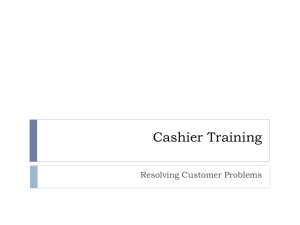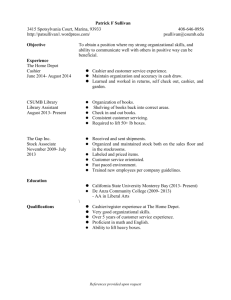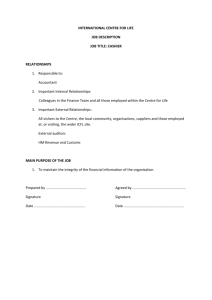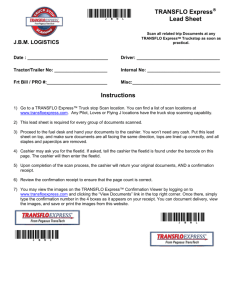Form 12-A - KN
advertisement
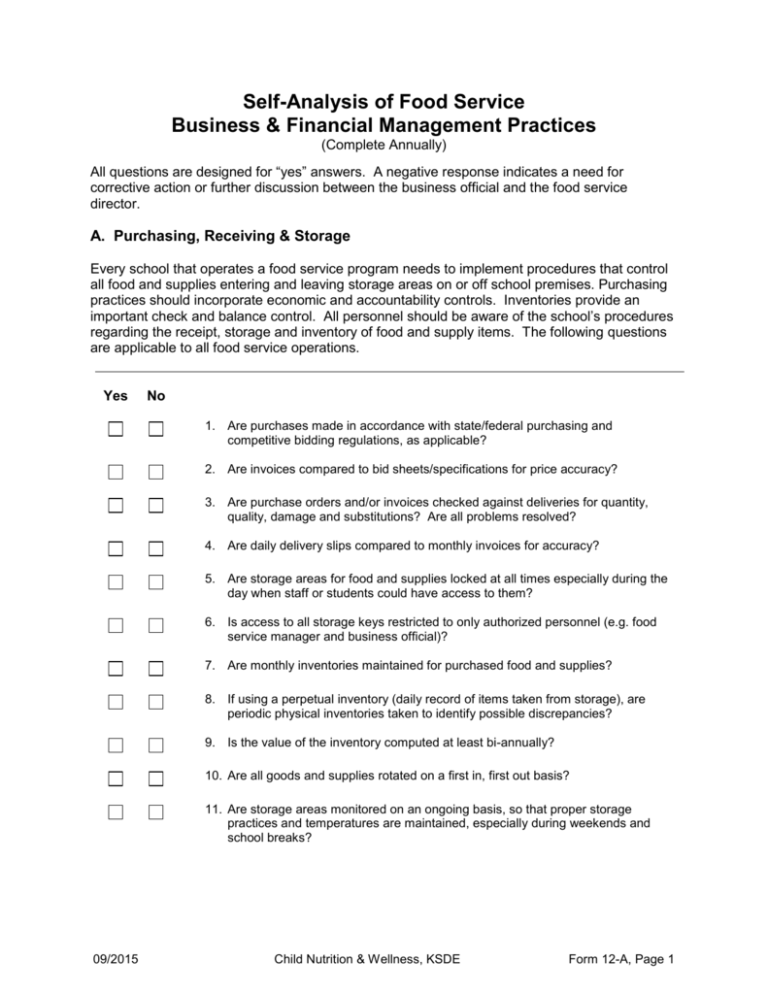
Self-Analysis of Food Service Business & Financial Management Practices (Complete Annually) All questions are designed for “yes” answers. A negative response indicates a need for corrective action or further discussion between the business official and the food service director. A. Purchasing, Receiving & Storage Every school that operates a food service program needs to implement procedures that control all food and supplies entering and leaving storage areas on or off school premises. Purchasing practices should incorporate economic and accountability controls. Inventories provide an important check and balance control. All personnel should be aware of the school’s procedures regarding the receipt, storage and inventory of food and supply items. The following questions are applicable to all food service operations. Yes No 09/2015 1. Are purchases made in accordance with state/federal purchasing and competitive bidding regulations, as applicable? 2. Are invoices compared to bid sheets/specifications for price accuracy? 3. Are purchase orders and/or invoices checked against deliveries for quantity, quality, damage and substitutions? Are all problems resolved? 4. Are daily delivery slips compared to monthly invoices for accuracy? 5. Are storage areas for food and supplies locked at all times especially during the day when staff or students could have access to them? 6. Is access to all storage keys restricted to only authorized personnel (e.g. food service manager and business official)? 7. Are monthly inventories maintained for purchased food and supplies? 8. If using a perpetual inventory (daily record of items taken from storage), are periodic physical inventories taken to identify possible discrepancies? 9. Is the value of the inventory computed at least bi-annually? 10. Are all goods and supplies rotated on a first in, first out basis? 11. Are storage areas monitored on an ongoing basis, so that proper storage practices and temperatures are maintained, especially during weekends and school breaks? Child Nutrition & Wellness, KSDE Form 12-A, Page 1 Self-Analysis of Food Service Business & Financial Management Practices B. Menus & Food Production Sound purchasing, storage and receiving practices go hand-in-hand with controlling food production costs. The following questions address the controls needed to prevent overspending, overproduction of food items, and use of food items for other than program purposes. Yes No 1. Are recipe and menu costs computed in order to stay within the food budget? 2. Is portion control implemented before and during meal service in each building? 3. Are food production and participation records analyzed daily to control under- 4. Are production records compared daily to receipts, sales and leftovers? 5. Have policies been established to use, store or discard leftovers in each production and/or over-production? building/serving site? C. Cash Sales & Receipts Tight controls are needed to protect cash, ensure the accurate accounting of all transactions (student meals, student and adult a la carte sales), and to provide a clear audit trail from the point of sale to the deposit slip and cashier’s report. The following questions incorporate controls that should be implemented at each school building where cash transactions take place. Yes No 1. Is money secure before, during and after meal service? 2. Is traffic flow past the cashier orderly and reasonably paced to prevent 3. Are employees trained to receive cash properly? 4. Are cashiers rotated frequently? If only one cashier is used, does the manager 5. If no cash register is used (e.g. cash box), are a la carte items and trays counted 6. Are all transactions separately and immediately recorded on a computer, register, 09/2015 unnecessary distractions and confusion? periodically act as a substitute? Are receipts monitored to verify that they are similar regardless of who cashiers? before and after the service to reconcile sales with receipts? tic sheet, count sheet or tape? Child Nutrition & Wellness, KSDE Form 12-A, Page 2 Self-Analysis of Food Service Business & Financial Management Practices C. Cash Sales & Receipts, continued Yes No 7. Are point-of-service records (cash register tapes, printouts, coded tickets, tic sheets) accurate and do they support data indicated on the cashier’s report? 8. Are all transactions identified by source (i.e. student reimbursable meals, 9. 10. 11. 12. 13. 14. 15. 16. 17. Are copies of cashier reports, monthly statements, etc., retained both in the 09/2015 a la carte, adult meals)? Is money recorded by denomination on the cashier’s report? Are policies/procedures established for cash overages and shortages? Are cashier’s reports completed in ink and signed by each cashier? Is money/cashier’s report given to designated personnel for review within 30 minutes after the service? Is all money collected and centrally counted for deposit? Are cashier’s reports compared with bank deposit slips for accuracy? Are persons responsible for transporting large sums of money bonded? If a petty cash fund is used: Are receipts kept to document all transactions? Is the fund audited/balanced frequently? sponsor’s office and the food service manager’s office? Child Nutrition & Wellness, KSDE Form 12-A, Page 3 Self-Analysis of Food Service Business & Financial Management Practices D. District Level Controls School business administrators, in conjunction with school food service administrators, need to know the strengths and weaknesses of the food service program in order to make necessary changes. The controls referenced in the questions listed below help to ensure the fiscal integrity of the food service program through frequent checks and balances. Yes No 1. Are the KSDE Monthly and Annual Financial Status Summaries completed within 2. Are monthly expenses and revenues compared with prior months and annual 3. Are frequent internal audits conducted to ensure the accuracy of reported 10. If meal tickets are used, are they pre-numbered to provide for usage controls? 11. Are the procedures used to verify information on Applications for Child Nutrition 12. Are computer accountability systems backed up daily? 09/2015 90 days following the end of the claim month? totals? Can deviations be explained? information (revenue totals reflect cash sales; accurate claims for reimbursement and expenses reflect only allowable costs)? 4. Are average costs and revenues per lunch calculated periodically? 5. Are meals per labor hour within acceptable guidelines? 6. Are daily work schedules used to optimize staffing? 7. Are non program food (student and adult) items priced to cover all costs? 8. Do all adults make payment for all meals received through the program? 9. Is the Food Service Fund reimbursed for all nonfood service gratis meals and low priced adult meals? Are meal counts compared against ticket usage? Program Benefits sufficiently documented, completed, and kept on file according to federal guidelines? Child Nutrition & Wellness, KSDE Form 12-A, Page 4 Self-Analysis of Food Service Business & Financial Management Practices E. Catering/Outside Use of Cafeteria Facilities If the sponsor provides catering services for school related functions, such as of board of education luncheons and sports banquets, procedures must be established to ensure the separation of these services from the Child Nutrition Program’s operation. In addition, controls need to be established when outside organizations such as a booster club or local PTO group, uses cafeteria facilities for outside fundraising activities (i.e. spaghetti dinner, pancake breakfasts or refreshments made available during bazaars, etc.). Yes No a. Is the cost of all food and supplies used for these functions billed to the function’s sponsor? b. Is all labor required for the function charged to the function’s sponsor? 1. When catering school-related functions: 2. When outside organizations/groups use school cafeteria facilities and equipment, are the following controls in place? a. Is a school food service employee, who is independent of the outside group, assigned to monitor the operation of equipment and ensure that school food service supplies are not used? b. Are fees charged to cover costs of possible clean up and equipment wear and tear? c. Is the sponsor’s inventory and equipment secured during non-working hours? Signature _________________________________________________________________ Title______________________________________________________________________ Date Completed ____________________________________________________________ Once completed, this survey should be kept on file at the school/district office to be used as a reference and resource. Adapted from Self-Analysis of Business Practices Relating to School Food Service, The State Department/University of the State of New York, Albany, N.Y. 09/2015 Child Nutrition & Wellness, KSDE Form 12-A, Page 5
